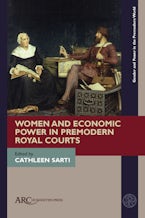- Home
- Gender and Power in the Premodern World
- history
- Women and Economic Power in Premodern Royal Courts
Women and Economic Power in Premodern Royal Courts
Edited by Cathleen Sarti
Series: Gender and Power in the Premodern World
108 Pages, Trim size: 6 x 9 in
- Hardcover
- 9781641892728
- Published: August 2020
$95.00
£79.00
Premodern kings and queens had splendid courts to show their God-given power. But where did the money for these come from? Following the money trail back often leads to unexpectedly savvy women who knew how to deal with money, and how to manage huge estates, treasuries, or accounts. This volume focuses on the economic and financial dimensions of the premodern royal court, and especially on the women using money as an instrument of power.
Methodological and theoretical reflections on an economic history of royal courts frame case studies from medieval England to early modern Denmark and the Holy Roman Empire. Empresses and queens, but also mistresses and favourites are discussed, including considerations of their spheres of influence, their financial strategies and means, and their successes and failures.
Introduction: Women and Economic Power at Premodern Royal Courts, Cathleen Sarti
The Medieval English Queen as Landholder: Some Reflections on Sources and Methodology, Michele Seah and Katia Wright
Financial Power of Empresses and Princesses of the Holy Roman Empire, Charlotte Backerra and Cathérine Ludwig-Ockenfels
“Edward III’s Gold Digging Mistress”: Alice Perrers, Gender and Financial Power at the English Royal Court, 1360-1377, Laura Tompkins
Counselling the Danish King: Sigbrit Villoms as Financial Mastermind for Christian II, 1513-1523, Cathleen Sarti
Afterword: “Power is Money”? Reflections on Money, Power, Sex and Gender in Premodern Royal Courts, Elena Woodacre
Recommended Literature
Cathleen Sarti teaches Early Modern History at the University of Mainz. She publishes about political culture in Northern Europe.
{B]y expanding the conversation about women’s power at royal courts to encompass economic power, the volume makes a valuable contribution to both royal studies and gender studies. In particular, it offers new avenues for connections and comparisons between women of different social strata in ways that discussions of queens’ political power usually do not.
~Sarah Ifft Decker, Speculum 97, no. 3 (2022): 885-86











